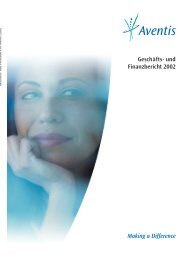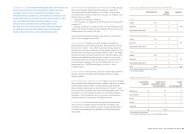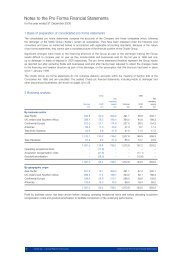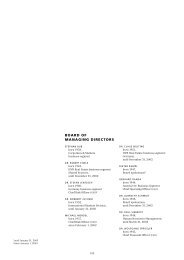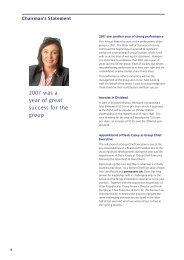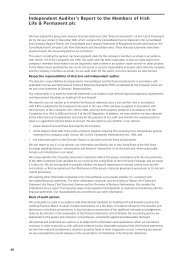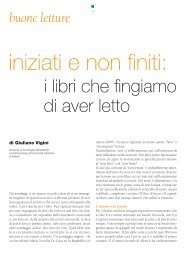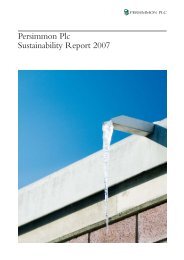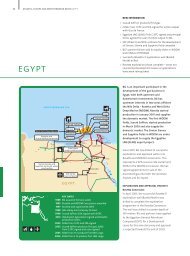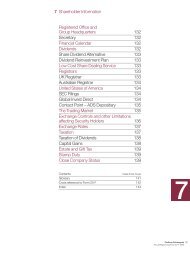Overview of Business Performance - Investis
Overview of Business Performance - Investis
Overview of Business Performance - Investis
Create successful ePaper yourself
Turn your PDF publications into a flip-book with our unique Google optimized e-Paper software.
12<br />
<strong>Overview</strong> <strong>of</strong> <strong>Business</strong> <strong>Performance</strong><br />
<strong>Business</strong> Review<br />
This business review has been prepared in accordance<br />
with the recommendations <strong>of</strong> the European Union<br />
(EU) Modernisation Directive and is in line with<br />
current best practice. It is addressed to, and written<br />
for, the members <strong>of</strong> Irish Life & Permanent plc with<br />
the objective <strong>of</strong> providing a fair review <strong>of</strong> the group’s<br />
business development, performance and position. This<br />
review aims to present a balanced and comprehensive<br />
overview <strong>of</strong> the business that is consistent with the<br />
size and complexity <strong>of</strong> the group. The review is written<br />
in the context <strong>of</strong> the risks and uncertainties facing the<br />
business.<br />
Key <strong>Performance</strong> Indicators<br />
The EU Modernisation Directive requires that business<br />
reviews contain fi nancial, and where applicable, nonfi<br />
nancial key performance indicators. We consider that<br />
our key fi nancial performance indicators (KPIs) are<br />
those that communicate the fi nancial performance and<br />
strength <strong>of</strong> the group as a whole to the members. These<br />
KPIs comprise:<br />
• Adjusted Operating Return on Capital Employed<br />
(European Embedded Value (“EV”)<br />
basis)<br />
• Operating Pr<strong>of</strong>i t on an EV basis<br />
• Proposed Ordinary Dividend<br />
• Risk Asset Ratio <strong>of</strong> the Bank<br />
• Solvency cover within the group’s life assurance<br />
business<br />
• Life and banking margins<br />
• Life internal rate <strong>of</strong> return (“IRR”)<br />
• Sales growth:<br />
- Life and Investment sales<br />
- Loan book growth<br />
- New current account customers<br />
Each <strong>of</strong> those KPIs is addressed in the body <strong>of</strong> this<br />
review.<br />
The group also uses a variety <strong>of</strong> KPIs in both running<br />
and assessing the performance <strong>of</strong> individual business<br />
units, rather than the group as a whole. KPIs include<br />
measures such as present value <strong>of</strong> new business<br />
premiums, new business margins, net interest margins,<br />
cost/income ratios and customer satisfaction ratings.<br />
Forward-looking Statements<br />
This business review contains “forward-looking<br />
statements” with respect to certain <strong>of</strong> the group’s plans<br />
and its current goals and expectations relating to its<br />
future fi nancial condition, performance and results. By<br />
their nature, all forward-looking statements involve risk<br />
and uncertainty because they relate to future events<br />
that are <strong>of</strong>ten beyond the group’s control. For example,<br />
certain insurance risk disclosures are dependent on<br />
choices about assumptions and models, and by their<br />
nature are best estimates. However, actual future gains<br />
and losses could differ materially from those that have<br />
been estimated. Other factors that could cause actual<br />
results to differ materially from those estimated by the<br />
forward-looking statements include, but are not limited<br />
to:<br />
• Irish domestic and global economic business<br />
conditions<br />
• Interest rates<br />
• Equity and property prices<br />
• The impact <strong>of</strong> competition, infl ation and defl ation<br />
• Changes to customers’ saving, spending and<br />
borrowing habits<br />
• The group’s success in managing the above factors<br />
As a result the actual future fi nancial condition and<br />
performance <strong>of</strong> the group may differ from the targets<br />
and goals set out in the forward-looking statements. The<br />
group has no obligation to update any forward-looking<br />
statements contained in this review.<br />
Accounting Basis <strong>of</strong> Preparation<br />
The group has prepared its fi nancial statements set<br />
out on pages 42 to 136 under International Financial<br />
Reporting Standards (IFRS) as adopted by the EU. In<br />
addition, on pages 137 to 155, the group has presented,<br />
as supplementary information, its results under<br />
European Embedded Value basis <strong>of</strong> accounting.<br />
Group <strong>Overview</strong> IFRS Results<br />
The group’s statutory consolidated income statement<br />
under IFRS is summarised below:<br />
2007 2006<br />
bm am<br />
Net interest income 480 409<br />
Other non interest income (49) (7)<br />
Premiums on insurance contracts<br />
Reinsurance share <strong>of</strong> premiums on<br />
718 584<br />
insurance contracts (311) (204)<br />
Fees from investment contracts 284 247<br />
Change in value <strong>of</strong> in-force 54 117<br />
Investment return (25) 2,813<br />
Pr<strong>of</strong>i t on sale <strong>of</strong> property and equipment 1 –<br />
Operating income 1,152 3,959
<strong>Overview</strong> <strong>of</strong> <strong>Business</strong> <strong>Performance</strong><br />
2007 2006<br />
bm am<br />
Claims on insurance contracts -<br />
net <strong>of</strong> reinsurance<br />
Change in insurance contract<br />
(322) (293)<br />
liabilities - net <strong>of</strong> reinsurance 177 (26)<br />
Change to investment contract liabilities 98 (2,672)<br />
Administration expenses<br />
Impairment losses on<br />
(541) (497)<br />
loans and receivables (28) (14)<br />
Other (88) (71)<br />
Operating expenses (704) (3,573)<br />
Operating pr<strong>of</strong>i t<br />
Share <strong>of</strong> pr<strong>of</strong>i ts <strong>of</strong> associated<br />
448 386<br />
undertakings / joint venture 29 55<br />
Pr<strong>of</strong>i t before tax 477 441<br />
Taxation (25) (80)<br />
Pr<strong>of</strong>i t for the year 452 361<br />
The EV basis results which are presented as<br />
supplementary information employ the embedded<br />
value methodology for all <strong>of</strong> the group’s insurance<br />
and investment business. The statutory results use<br />
embedded value for insurance contracts only with<br />
investment contracts being accounted for under IAS 39.<br />
Banking and other businesses are accounted for on the<br />
same basis in both statutory and EV results.<br />
Total statutory basis pr<strong>of</strong>i ts after tax increased 25% to<br />
a452m (2006: a361m). The pr<strong>of</strong>i t before tax at a477m<br />
was 8% ahead <strong>of</strong> 2006 (a441m).<br />
Operating income at a1,152m was signifi cantly lower<br />
than 2006 (a3,959m) principally due to a reduction<br />
in the investment return which was a negative a25m<br />
in 2007 compared to a positive a2,813m in 2006. This<br />
reduction principally refl ects the impact <strong>of</strong> lower<br />
investment market returns on policyholder funds.<br />
Operating expenses <strong>of</strong> a704m were also signifi cantly<br />
lower than 2006 (a3,573m) principally due to a<br />
reduction in the change in insurance and investment<br />
liabilities again due to the reduction in investment<br />
return on policyholder funds.<br />
The 2007 outcome also includes gains <strong>of</strong> a73m in<br />
respect <strong>of</strong> the fall in the value <strong>of</strong> Irish Life & Permanent<br />
shares held for the benefi t <strong>of</strong> policyholders which<br />
reduced policyholder liabilities but under IFRS the<br />
corresponding fall in the value <strong>of</strong> the assets is not<br />
recognised. In 2006 this item resulted in a charge <strong>of</strong><br />
a28m as there was an increase in the value <strong>of</strong> the shares<br />
in the year.<br />
Net interest income increased 17% principally refl ecting<br />
growth <strong>of</strong> 16% to a39.2bln (2006: a33.8bln) in the<br />
bank’s loan balances outstanding.<br />
The group enjoyed signifi cant growth in new business<br />
on both insurance and investment contracts which is<br />
refl ected in the 23% growth in premiums on insurance<br />
contract from a584m in 2006 to a718m in 2007 and<br />
15% growth in fees from investment contracts to<br />
a284m (2006: a247m). Refl ecting the strong growth in<br />
new business the net new business contribution was<br />
a negative a1m in the reported 2007 statutory pr<strong>of</strong>i ts,<br />
compared to a negative contribution <strong>of</strong> a8m in 2006,<br />
as under IFRS the fi xed cost <strong>of</strong> acquiring investment<br />
contract new business is recognised in the year <strong>of</strong><br />
acquisition whilst pr<strong>of</strong>i t fl ows are recognised over the<br />
life <strong>of</strong> the contract.<br />
The change in insurance contract liabilities shows<br />
a net reduction in liabilities <strong>of</strong> a177m compared to<br />
an increase <strong>of</strong> a26m in 2006. This is mainly due to<br />
reductions in insurance linked liabilities arising from<br />
negative market moves in 2007 compared to positive<br />
moves in 2006. The change in investment contract<br />
liabilities has decreased from a2,672m negative in 2006<br />
to a98m positive mainly due to investment market falls<br />
in 2007. The change in these liabilities are refl ected in<br />
the negative investment return <strong>of</strong> a25m included in<br />
operating income in 2007 compared to a positive return<br />
<strong>of</strong> a2,813m in 2006.<br />
Administrative expenses increased 9% to a541m in<br />
2007 from a497m in 2006. This principally refl ects the<br />
increase in costs associated with the buoyant new<br />
business issued.<br />
The post-tax pr<strong>of</strong>i ts achieved in Allianz, (a general<br />
insurance business in which the group has a 30%<br />
interest) in 2007, were a31m, compared to a56m in<br />
2006 where lower underwriting pr<strong>of</strong>i ts were <strong>of</strong>fset by<br />
the pr<strong>of</strong>i t from the sale <strong>of</strong> the business’s head <strong>of</strong>fi ce and<br />
higher investment returns.<br />
Under IFRS the effective tax rate is distorted by the<br />
inclusion <strong>of</strong> additional tax paid by policyholders. The<br />
tax charge in 2007 was a25m compared to a80m in<br />
2006 largely refl ecting the investment returns achieved<br />
by policyholders in both years.<br />
Corporate Responsibility<br />
The group has a strong commitment to corporate<br />
responsibility (“CR”). The board has responsibility<br />
for setting overall policy and objectives for CR and<br />
receives regular updates on the groups CR activities<br />
and plans. The group has a CR manager in place who<br />
is responsible for the day to day management <strong>of</strong> the<br />
CR programme. The programme is overseen in the fi rst<br />
instance by the Group CR Committee which is chaired<br />
by a senior executive and comprises representatives<br />
from across the group. This committee meets quarterly<br />
to review progress in implementing the CR programme<br />
and deciding a future direction. All staff are involved in<br />
implementing CR throughout the organisation.<br />
13
14<br />
<strong>Overview</strong> <strong>of</strong> <strong>Business</strong> <strong>Performance</strong><br />
The CR programme addresses such issues as our values<br />
as a company and how we apply them including, our<br />
standards <strong>of</strong> customer care, our involvement with<br />
local communities and reducing our impact on the<br />
environment. Details <strong>of</strong> our CR initiatives and activities<br />
in 2007 and our plans for 2008 are set out in full detail<br />
in our Corporate Responsibility Report 2007 which is<br />
available on our website at www.irishlifepermanent.ie.<br />
Risk Governance Structure<br />
The board <strong>of</strong> directors approves overall policy in relation<br />
to the types and level <strong>of</strong> risk that the group is permitted<br />
to assume in the implementation <strong>of</strong> its strategic and<br />
business plans.<br />
The Group Risk Committee, which was established<br />
during 2007, is chaired by the Group Chief Executive<br />
and comprises members <strong>of</strong> senior management. It is<br />
the executive committee with overall responsibility<br />
for risk management across the group. The Group Risk<br />
Committee exercises authority delegated by the Board<br />
<strong>of</strong> Directors to set policies in relation to specifi c risk<br />
categories and to monitor total risk levels across the<br />
group, in line with the overall policy approved by the<br />
Board <strong>of</strong> Directors.<br />
The Group Risk Committee, in turn, delegates<br />
responsibility for the monitoring and management <strong>of</strong><br />
specifi c risks to committees accountable to it.<br />
The committees reporting into the Group Risk<br />
Committee include the Group Assets and Liabilities<br />
Committee, the Group Credit Committee, the Group<br />
Operational Risk Committee and the Bank Basel<br />
Review Group. These committees monitor and manage<br />
credit, liquidity, market, insurance and operational risk,<br />
ensuring that the group’s objectives and risk policies<br />
are adhered to. (Refer to note 51 for more detailed<br />
information.)<br />
Corporate Activity<br />
In November 2007, the group consolidated its holding<br />
in Irish Life International by buying out the minority<br />
25% shareholding for a7m.<br />
Basel II (Revised Capital Framework)<br />
Implementation<br />
During the year the group continued with its<br />
preparations for the implementation <strong>of</strong> the new<br />
regulatory requirements <strong>of</strong> Basel II as interpreted in<br />
the EU through the Capital Requirements Directive<br />
(“CRD”). In implementing Basel II, the group has<br />
adopted the Internal Ratings Based (“IRB”) approach<br />
to credit risk and was awarded IRB accreditation in<br />
late 2007. In addition, the group submitted its Internal<br />
Capital Adequacy Assessment Process (“ICAAP”),<br />
which is a process for assessing its overall capital<br />
adequacy in relation to its risk pr<strong>of</strong>i le and a strategy<br />
for maintaining its capital levels, to the Financial<br />
Regulator in June 2007. Implementation <strong>of</strong> CRD<br />
required signifi cant changes to the group’s existing<br />
risk management structures and processes in addition<br />
to changes in the way in which the group’s required<br />
level <strong>of</strong> regulatory capital is computed. The group is<br />
confi dent that the signifi cant investment involved in<br />
Basel II implementation will materially enhance the<br />
sound risk management framework already in place<br />
within the group and will drive signifi cant advantages in<br />
terms <strong>of</strong> risk management and capital effi ciency for the<br />
group.<br />
Further details are set out in note 46 to the accounts.<br />
Capital and Liquidity<br />
The group’s capital ratios remained strong at 31<br />
December 2007. In the bank, the Tier 1 and total<br />
capital ratios were 10.4% (31 December 2006: 10.4%)<br />
compared to a required ratio <strong>of</strong> 9.5%. The solvency<br />
margin in Irish Life Assurance plc, the group’s principal<br />
life assurance business, was covered 1.6 times by<br />
available assets (31 December 2006: 1.8 times).<br />
During the fi rst half <strong>of</strong> 2007 the Irish Financial Regulator<br />
changed the regulations concerning the liquidity<br />
requirements <strong>of</strong> the Irish banking system. Previously<br />
Irish banks were required to meet a minimum 25%<br />
liquidity ratio (IL&P’s liquidity ratio at 31 December<br />
2006 was 26%). Under the new protocol required<br />
liquidity holdings are based upon various cash fl ow<br />
stress tests. The key limits applied are that an institution<br />
must have suffi cient available liquidity to cover 100% <strong>of</strong><br />
outfl ows over the next eight days and 90% <strong>of</strong> outfl ows<br />
over the next month. Throughout the year the group<br />
operated comfortably within these limits.<br />
Details <strong>of</strong> the group’s capital management are set out in<br />
Note 46 to the accounts.<br />
Dividend<br />
The directors have declared a fi nal dividend <strong>of</strong> 52.5<br />
cent per share. Subject to shareholder approval the<br />
dividend will be paid on 28 May 2008 to shareholders<br />
on the register as at 25 April 2008. The ex-dividend date<br />
is 23 April 2008. The fi nal dividend will bring the total<br />
dividend for the year to 75.0 cent, an increase <strong>of</strong> 10.3%<br />
on the 2006 total dividend <strong>of</strong> 68.0 cent. On an IFRS<br />
basis, the dividend is covered 2.2 times by total pr<strong>of</strong>i t.<br />
On the supplementary embedded value basis, the<br />
dividend is covered 2.0 times by total pr<strong>of</strong>i t (2.6 times<br />
at the operating level) and represents an approximate<br />
yield <strong>of</strong> 7.2% on the basis <strong>of</strong> the share price at the end<br />
<strong>of</strong> February 2008.<br />
Supplementary Group Reporting - European<br />
Embedded Value<br />
Irish Life has, since its fl otation in 1991, adopted<br />
embedded value accounting as its primary reporting<br />
basis for its life assurance activities. Despite the<br />
transition to IFRS, the group has continued to provide<br />
supplementary information on this basis, covering both<br />
investment and insurance contracts linked into Life<br />
<strong>Business</strong>. While supporting the stated objectives <strong>of</strong> IFRS
<strong>Overview</strong> <strong>of</strong> <strong>Business</strong> <strong>Performance</strong><br />
the group, and the life industry in general, is <strong>of</strong> the view<br />
that the new IFRS basis is less satisfactory in terms <strong>of</strong><br />
the measurement and reporting <strong>of</strong> the pr<strong>of</strong>i tability and<br />
the value added from writing long-term life assurance<br />
business, specifi cally what is now categorised as<br />
“investment” business. Accordingly, the group continues<br />
to manage all <strong>of</strong> its life assurance business on the basis<br />
<strong>of</strong> embedded value metrics and to provide embedded<br />
value results to shareholders and the market by way <strong>of</strong><br />
supplementary fi nancial reporting.<br />
Embedded value seeks to measure the value <strong>of</strong> the<br />
shareholders’ interest in a life assurance business. This<br />
consists <strong>of</strong> the shareholders’ equity - represented by<br />
net assets - plus the present value (i.e. a discounted<br />
cash fl ow) <strong>of</strong> future pr<strong>of</strong>i ts to be earned from the<br />
existing book <strong>of</strong> in-force business less the cost <strong>of</strong><br />
required capital. Future pr<strong>of</strong>i ts are estimated using<br />
actuarial methods and best estimate assumptions<br />
regarding future expenses, lapses, mortality, interest<br />
rates etc. Embedded value does not include any value<br />
attributable to future new business.<br />
The embedded value methodology adopted is in<br />
accordance with the European embedded value<br />
principles introduced by the CFO forum in May 2004,<br />
and updated in October 2005.<br />
The IL&P group has adopted the EV framework for the<br />
fi nancial reporting <strong>of</strong> its group results. In the group EV<br />
basis results, life assurance activities - covering both<br />
insurance and investment contracts - are accounted for<br />
on an embedded value basis and banking and other<br />
activities are accounted for on an IFRS basis.<br />
Supplementary Group Reporting - European<br />
Embedded Value Basis (“EV”)<br />
2007 2006<br />
bm<br />
Operating pr<strong>of</strong>i t on continuing operations<br />
am<br />
Insurance and investment business 346 274<br />
Banking 219 202<br />
Other (4) (2)<br />
561 474<br />
Share <strong>of</strong> associate / joint venture<br />
Operating pr<strong>of</strong>i t before tax on<br />
29 55<br />
continuing operations 590 529<br />
Short-term investment fl uctuations (114) 101<br />
Effect <strong>of</strong> economic assumption changes (14) (38)<br />
Other non operational costs (3) –<br />
Pr<strong>of</strong>i t on sale <strong>of</strong> property 1 –<br />
Pr<strong>of</strong>i t before tax 460 592<br />
Taxation (52) (28)<br />
Pr<strong>of</strong>i t after tax 408 564<br />
Minority interest<br />
Pr<strong>of</strong>i t after tax attributable to<br />
(4) (3)<br />
equityholders 404 561<br />
Group Income Statement<br />
Total pr<strong>of</strong>i t after tax attributable to equityholders was<br />
a404m compared to a561m in 2006. This outcome<br />
refl ects strong growth in pre-tax operating pr<strong>of</strong>i t - which<br />
was ahead 12% to a590m (2006: a529m) - but which<br />
was <strong>of</strong>fset by the impact <strong>of</strong> weaker investment markets<br />
and rising interest rates on the embedded value <strong>of</strong> the<br />
group’s life business which resulted in negative short<br />
term investment fl uctuations <strong>of</strong> a114m, compared to<br />
a positive a101m in 2006, and economic assumption<br />
changes which were a negative a14m (2006: negative<br />
a38m).<br />
At the operating level pre-tax pr<strong>of</strong>i ts <strong>of</strong> the group’s core<br />
banking and life assurance business grew 18% to a561m<br />
from a474m in 2006. This principally refl ects growth<br />
<strong>of</strong> 26% in the life business embedded value pr<strong>of</strong>i ts to<br />
a346m (2006: a274m) - driven by strong growth in the<br />
new business contribution and the expected return on<br />
the existing business - and 8% growth in the banking<br />
business to a219m (2006: a202m). The outturn in<br />
the banking business was depressed by a once <strong>of</strong>f<br />
charge <strong>of</strong> a11.7m in respect <strong>of</strong> exposures created by<br />
the fraudulent activities <strong>of</strong> a rogue solicitor. Excluding<br />
this once-<strong>of</strong>f specifi c provision the underlying level <strong>of</strong><br />
growth in the bank was 14% refl ecting good growth in<br />
net interest income driven by balance sheet growth.<br />
The post tax return from the group’s interest in Allianz<br />
(Ireland) Limited was a31m compared to a56m in 2006.<br />
This reduction in pr<strong>of</strong>i ts principally refl ects a lower<br />
underwriting result due to further s<strong>of</strong>tening <strong>of</strong> premium<br />
rates in the market in 2007 combined with the fact that<br />
the 2006 outcome benefi ted from signifi cant prior year<br />
claims reserve releases.<br />
Short-term investment fl uctuations refl ect the impact<br />
<strong>of</strong> actual against assumed investment returns on the<br />
embedded value <strong>of</strong> the group’s life operations. The<br />
outcome was a negative a114m in 2007 compared to a<br />
positive a101m in 2006 and refl ects the signifi cant down<br />
turn in investment markets in the second half <strong>of</strong> 2007.<br />
In 2007, changes in the economic assumptions used to<br />
calculate the life assurance embedded value resulted in<br />
a negative a14m outcome (2006: negative a38m). This<br />
principally relates to the impact <strong>of</strong> an increase in the<br />
risk discount rate used to compute the embedded value<br />
from 7.4% to 7.8%, refl ecting increases in medium term<br />
euro bond rates. In 2006, changes in the risk discount<br />
rate from 6.5% to 7.4% had a a38m negative impact on<br />
the embedded value.<br />
The taxation charge <strong>of</strong> a52m is comprised <strong>of</strong> two<br />
elements, a a54m (2006: a42m) charge on insurance<br />
and banking operating pr<strong>of</strong>i ts and a credit <strong>of</strong> a2m (2006:<br />
a14m) attributable to investment fl uctuations and<br />
economic assumption changes in the life embedded<br />
value. The effective tax rate <strong>of</strong> 10% on operating<br />
pr<strong>of</strong>i t (combined insurance and banking) is lower than<br />
expected, benefi ting from the release <strong>of</strong> some a10m <strong>of</strong><br />
15
16<br />
<strong>Overview</strong> <strong>of</strong> <strong>Business</strong> <strong>Performance</strong><br />
life tax reserves.<br />
The adjusted operating return on capital employed<br />
(excluding associate/joint venture and own share<br />
adjustment) was 15.7% at the end <strong>of</strong> 2007 compared to<br />
15.0% achieved in 2006.<br />
Asset Portfolios<br />
Movements in asset values, currencies and interest rates<br />
impact the embedded value <strong>of</strong> the group’s life business<br />
and the mark to market valuation <strong>of</strong> the bank’s liquidity<br />
/ investment portfolios.<br />
Life Assurance Asset Portfolio<br />
The embedded value <strong>of</strong> the group’s life operations<br />
is exposed to market movements in asset currencies<br />
and interest rates due to the fact that the embedded<br />
value is calculated using assumptions regarding future<br />
investment returns and interest rates. To the extent<br />
that actual returns and interest rates differ from the<br />
assumptions used, variances will arise which may be<br />
positive or negative.<br />
As a result <strong>of</strong> the sharp fall in investment markets in the<br />
second half <strong>of</strong> 2007 the actual returns on investment<br />
markets fell signifi cantly short <strong>of</strong> the embedded value<br />
assumptions, resulting in a negative variance on<br />
short-term investment fl uctuations <strong>of</strong> a114m in 2007<br />
compared to a positive a101m experienced in 2006. The<br />
bulk <strong>of</strong> this variance represents the present value <strong>of</strong> the<br />
reduction <strong>of</strong> future fund management fee income from<br />
unit linked funds as a consequence <strong>of</strong> the fall in unit<br />
prices.<br />
In addition, the increase in medium term euro interest<br />
rates has led to an increase in the risk discount rate<br />
used to compute the embedded value from 7.4% to<br />
7.8%. This is the principal reason behind the negative<br />
economic variance <strong>of</strong> a14m recorded in 2007, which<br />
compares to a negative a38m in 2006 when the<br />
risk discount rate increased to 7.4% from 6.5% as a<br />
consequence <strong>of</strong> rising medium term euro bond rates.<br />
The sensitivity <strong>of</strong> the embedded value to changes in<br />
markets is set out in detail in note 14. In summary, a 1%<br />
increase in interest rates reduces the embedded value<br />
by a28m (1.4%) <strong>of</strong> the total embedded value, while a<br />
1% decrease in rates increases the embedded value by<br />
a32m (1.6%). A 10% reduction in equity and property<br />
values would reduce the embedded value by a103m<br />
(5%).<br />
The group’s life business is a relatively low risk<br />
operation. With regard to the unit-linked portfolio <strong>of</strong><br />
a27.9bln, which represents 94% (net <strong>of</strong> reinsurance) <strong>of</strong><br />
the life company liabilities, the investment risk in this<br />
portfolio is primarily borne by the policyholders.<br />
In the non-linked or traditional insurance portfolio<br />
the group’s policy is to match liability fl ows with high<br />
quality assets, principally sovereign bonds. The average<br />
duration <strong>of</strong> the non-linked liabilities is 8.6 years while<br />
the average duration <strong>of</strong> the assets matching these<br />
liabilities is 8.5 years.<br />
The assets held in the fund total a1.7bln and the credit<br />
pr<strong>of</strong>i le <strong>of</strong> the portfolio is as follows:<br />
%<br />
Aaa 70<br />
Aa 23<br />
A 7<br />
100<br />
Given the close duration match, any mark to market<br />
adjustments in the portfolio due to changes in yield<br />
curves are generally matched by equal and opposite<br />
movements in the value <strong>of</strong> the liabilities.<br />
In the year ended 2007 one asset held in the portfolio,<br />
valued at a38m, was subject to an impairment writedown<br />
<strong>of</strong> a8m. Excluding this item there were no other<br />
impairment write-downs in the portfolio.<br />
The life company’s shareholder funds are principally<br />
invested in cash and owner occupied property. A full<br />
analysis <strong>of</strong> the life shareholder fund investments is set<br />
out in Note 5.<br />
Bank Asset Portfolio<br />
The bank’s liquidity portfolio <strong>of</strong> a4.2bln is principally<br />
held in sovereign bonds (59%), highly rated bank FRN’s<br />
(28%) and prime (non-US) euro denominated RMBS<br />
(13%). There are no sub-prime assets held within<br />
the portfolio. The portfolio is rated 73% Aaa, 20%<br />
Aa and 7% A. The mark to market adjustment to this<br />
portfolio at year end was a negative a19m gross which,<br />
in accordance with the IAS39 accounting treatment<br />
applied to “available for sale” assets, was taken to<br />
reserves.<br />
At 31 December 2007, the group held a a2.5bln debt<br />
securities portfolio designated as being “Held to<br />
Maturity”. This portfolio formed part <strong>of</strong> the group’s<br />
holdings with respect to liquidity management. At the<br />
year end the group had the ability and intention to hold<br />
the portfolio to maturity. However, in February 2008,<br />
increased market volatility presented the group with<br />
an opportunity to realise a gain <strong>of</strong> a29m on the sale<br />
<strong>of</strong> the portfolio. The group availed <strong>of</strong> this opportunity<br />
and disposed <strong>of</strong> the entire portfolio. The gain will be<br />
recognised in the 2008 results.<br />
Funding<br />
The regulatory regime under which the bank operates<br />
requires it to have suffi cient liquidity available to cover<br />
100% <strong>of</strong> outfl ows over the next eight days and 90% <strong>of</strong><br />
outfl ows over the next 30 days. Throughout the year the<br />
group operated comfortably within these limits.<br />
The diversifi cation and duration pr<strong>of</strong>i le <strong>of</strong> the group’s<br />
funding sources leave it in a strong position in the<br />
current credit environment. At the year end 64% <strong>of</strong> the
<strong>Overview</strong> <strong>of</strong> <strong>Business</strong> <strong>Performance</strong><br />
bank’s funding base comprised customer accounts and<br />
long-term debt. In addition the high quality and low risk<br />
nature <strong>of</strong> the group’s lending activities - overwhelmingly<br />
prime residential mortgages provide a pool <strong>of</strong> assets<br />
against which funding can be drawn through the ECB<br />
repurchase facility. At 31 December 2007 available<br />
ECB facilities totalled a17.2bln, (a20bln nominal<br />
collateralised asset pool), against which drawings <strong>of</strong><br />
a5.3bln had been made. The balance <strong>of</strong> a11.9bln,<br />
which is available together with the other eligible assets<br />
which have not yet been collateralised, provide a secure<br />
underpinning <strong>of</strong> the groups’ funding requirements for<br />
2008.<br />
In the latter part <strong>of</strong> 2007 in response to the increased<br />
cost <strong>of</strong> wholesale funding, the group increased<br />
mortgage and other credit interest rates on selected<br />
products in order to protect margins against increased<br />
wholesale funding rates.<br />
DIVISIONAL PERFORMANCE REVIEW<br />
Insurance and Investment Operating Review<br />
2007 was an extremely buoyant year for life and<br />
investment business in Ireland, and all <strong>of</strong> the group’s<br />
divisions - Retail, Corporate <strong>Business</strong> and ILIM -<br />
performed extremely well.<br />
The life and investment business had two major points<br />
<strong>of</strong> focus during 2007- positioning Irish Life as the<br />
dominant pension solutions provider in Ireland and<br />
developing our life business to enable it capture the<br />
wealth management opportunity in Ireland, which<br />
has arisen through the growth in mass affl uence. In<br />
2007 pensions sales were ahead 39% year-on-year and<br />
accounted for 59% <strong>of</strong> total group life sales in Irish Life<br />
Assurance. Progress has also been made on our wealth<br />
management objective. We have started to build the<br />
competencies and know how in our existing distribution<br />
channels to enable us to access a bigger share <strong>of</strong> this<br />
rapidly growing market, as well as establishing some<br />
new structures in the group, focused exclusively on<br />
the high net worth and mass affl uent sector, which will<br />
be responsible for developing new products and new<br />
distribution to fully exploit this opportunity.<br />
In the Retail Life division sales growth <strong>of</strong> 31% to a414m<br />
(2006: a317m) led to an increase in market share to in<br />
excess <strong>of</strong> 25% with all distribution channels and product<br />
lines performing well. In the Corporate <strong>Business</strong><br />
division sales increased 33% and this division continues<br />
to be the dominant force in the corporate life and<br />
pensions arena. Driven by excellent fund management<br />
performance in both their passive and active funds, ILIM<br />
had a record sales year with gross investment infl ows <strong>of</strong><br />
a3.4bln, a 79% increase on the funds infl ow <strong>of</strong> a1.9bln<br />
in 2006.<br />
APE 1 sales in the group’s principal life businesses are<br />
summarised below:<br />
2007 2006<br />
bm am %<br />
Retail Life 414 317 31<br />
Corporate Life 220 165 33<br />
Irish Life International 39 34 15<br />
673 516 30<br />
Investment (ILIM) 341 190 79<br />
1,014 706 44<br />
PVNBP 2 sales in the group’s principal life businesses are<br />
summarised below:<br />
2007 2006<br />
bm am %<br />
Retail Life 2,745 2,145 28<br />
Corporate Life 1,355 998 36<br />
Irish Life International 390 339 15<br />
4,490 3,482 29<br />
Investment (ILIM) 3,406 1,901 79<br />
7,896 5,383 47<br />
1<br />
APE sales are calculated as annual value <strong>of</strong> regular premiums plus 10%<br />
<strong>of</strong> the value <strong>of</strong> single premiums<br />
2<br />
PVNBP sales are calculated as total single premiums plus the<br />
discounted value <strong>of</strong> regular premiums expected to be received over the<br />
term <strong>of</strong> the contracts<br />
Retail Life<br />
The group’s retail business concentrates on sales <strong>of</strong> life<br />
and pensions products to the retail market in Ireland. It<br />
is a market leader with a comprehensive product range<br />
spanning pensions, protection, investment and regular<br />
savings with a market share in excess <strong>of</strong> 25%.<br />
The Retail Life business follows a multi-channel<br />
distribution strategy with independent brokers,<br />
bancassurance (via permanent tsb), direct sales,<br />
franchises, institutional (other bank branches) and<br />
telephone / internet channels providing the business<br />
with unrivalled distribution reach and customer access<br />
points. This distribution reach ensures that the business<br />
is not overly dependant on one channel.<br />
The retail life assurance market was extremely buoyant<br />
in 2007 and sales in the Retail Life division increased<br />
31% to a414m (2006: a317m). On a PVNBP basis,<br />
sales were ahead 28% to a2.7bln (2006: a2.1bln).<br />
The principal drivers <strong>of</strong> the sales performance were<br />
pensions (up 46%) and investments (up 23%). Both<br />
lines <strong>of</strong> business benefi ted from the group’s excellent<br />
investment performance and track record, with<br />
pensions also benefi ting from the introduction <strong>of</strong> a<br />
new self administered pension product and lump sum<br />
investments benefi ting from maturing SSIA accounts in<br />
17
18<br />
<strong>Overview</strong> <strong>of</strong> <strong>Business</strong> <strong>Performance</strong><br />
the fi rst half <strong>of</strong> the year. Growth in protection sales were<br />
more subdued (up 2%) refl ecting the slowdown in the<br />
residential mortgage market during the year.<br />
Corporate Life<br />
The Corporate Life division is engaged in the sale <strong>of</strong><br />
pension and risk schemes to employers and affi nity<br />
groups in Ireland. It has a leading position in this market<br />
with an estimated market share <strong>of</strong> 45%. Distribution<br />
is principally through pension consultants and brokers<br />
(including Cornmarket, a specialist affi nity broker in<br />
which the group has a 75% interest).<br />
Customer service levels are a key differentiator <strong>of</strong><br />
providers in the market and the Corporate Life division<br />
has achieved competitive advantage through continued<br />
and sustained investment in both staff and technology<br />
in order to achieve signifi cant improvement in service<br />
levels and customer satisfaction. This focus on service<br />
level improvements will continue to be a feature <strong>of</strong> the<br />
division’s agenda into the future.<br />
The key driver <strong>of</strong> new business sales in Corporate<br />
Life is employment and salary growth in the Irish<br />
economy. 2007 saw continued strong growth in the Irish<br />
economy with increasing employment and continued<br />
good growth in salaries and wages. This provided an<br />
excellent economic backdrop for the group’s Corporate<br />
Life business with sales growing 33% to a220m (2006:<br />
a165m). On a PVNBP basis, sales were ahead 36%<br />
to a1.4bln (2006: a1.0bln). The sales performance<br />
was particularly driven by a high level <strong>of</strong> new defi ned<br />
contribution schemes (up 30%) and annuity sales (up<br />
65%) which benefi ted from a large number <strong>of</strong> annuity<br />
purchases to buy out defi ned benefi t pension scheme<br />
liabilities.<br />
Investment Management<br />
Irish Life Investment Managers (ILIM) provides<br />
investment management services for the group’s life<br />
and pensions business in addition to managing large<br />
segregated funds. ILIM <strong>of</strong>fers a wide range <strong>of</strong> active,<br />
consensus and multi manager funds with a key focus <strong>of</strong><br />
the business being on product innovation. The business<br />
has grown rapidly in the past number <strong>of</strong> years and now<br />
ranks as the second largest fund manager in Ireland as<br />
measured by funds under management.<br />
The group’s investment management performance<br />
continued to be excellent in 2007 on both the active<br />
and passive side <strong>of</strong> the business. This led to record<br />
levels <strong>of</strong> fund infl ows with gross new infl ows <strong>of</strong> a3.4bln<br />
(including a645m arising from the acquisition <strong>of</strong> the EBS<br />
Summit Funds) compared to a1.9bln in 2006. Refl ecting<br />
the strong levels <strong>of</strong> gross new infl ows, total funds<br />
under management increased 11% to a35.4bln (2006:<br />
a31.8bln) notwithstanding the falls in global equity<br />
markets in the second half <strong>of</strong> the year.<br />
Insurance and Investment Financial Review<br />
The operating results <strong>of</strong> the group’s insurance and<br />
investment business, presented on an EV basis, for the<br />
year ended 31 December 2007 are set out below:<br />
2007 2006<br />
bm am<br />
New business contribution<br />
Contribution from in-force business<br />
Expected return<br />
154 128<br />
In-force 118 89<br />
Net worth 29 26<br />
Experience variances 10 14<br />
Assumption changes 35 17<br />
192 146<br />
Operating pr<strong>of</strong>i t before tax 346 274<br />
The operating pr<strong>of</strong>i t before tax for the year ended 2007<br />
was a346m, a 26% uplift on 2006 (a274m). The key<br />
drivers <strong>of</strong> this performance were strong growth in the<br />
new business contribution, which was ahead 20% to<br />
a154m (2006: a128m), and good growth in the expected<br />
in-force return which grew 33% to a118m from a89m in<br />
2006 refl ecting growth in the book.<br />
New <strong>Business</strong> Contribution & Margins<br />
The new business contribution increased 20% to<br />
a154m from a128m in 2006. This outcome was driven<br />
by a 30% increase in life new business sales (excluding<br />
ILIM) to a673m on an APE basis (compared to a516m<br />
in 2006) combined with a strong new business margin<br />
performance. On a PVNBP basis sales, excluding ILIM,<br />
were ahead 29% to a4.5bln (2006: a3.5bln).<br />
Overall new business margins, excluding ILIM, were<br />
19.2%, compared to 20.6% reported in 2006. Including<br />
ILIM, new business margins were 15.3% compared to<br />
18.1% in 2006, made up as follows:<br />
2007 2006<br />
% %<br />
Life 19.2 20.6<br />
Investment (ILIM) 7.4 11.4<br />
15.3 18.1<br />
The continued strength in life margins (19.2%) in<br />
2007 refl ects the high volume <strong>of</strong> new business sales.<br />
The reduction in margins from the exceptional levels<br />
achieved in 2006 (20.6%) refl ects a change in the<br />
product mix with a higher proportion <strong>of</strong> single premium<br />
investment sales being achieved in 2007 and a relatively<br />
lower proportion <strong>of</strong> higher margin protection business,<br />
combined with the impact <strong>of</strong> the increase in the<br />
opening risk discount rate from 6.5% to 7.4% which had<br />
a negative impact on 2007 margins. The reduction in<br />
margins in ILIM refl ect a larger proportion <strong>of</strong> high ticket<br />
low margin sales within the mix in 2007.<br />
When calculated on the basis <strong>of</strong> present value <strong>of</strong> new<br />
business premiums (“PVNBP”) new business margins,
<strong>Overview</strong> <strong>of</strong> <strong>Business</strong> <strong>Performance</strong><br />
including ILIM, were 2.0% in 2007 (2006: 2.4%).<br />
The PVNBP margin is calculated as follows:<br />
2007 2006<br />
% %<br />
Life 2.9 3.1<br />
Investment (ILIM) 0.7 1.1<br />
2.0 2.4<br />
The internal rate <strong>of</strong> return achieved on new business<br />
sales, excluding ILIM, was 13.3% which compares to<br />
12.1% achieved in 2006. The average payback period 3<br />
across the group’s life product set was 6 years. The<br />
consolidated internal rate <strong>of</strong> return achieved on<br />
new business sales, including ILIM, was 14.3% which<br />
compares to 13.2% achieved in 2006.<br />
In-force <strong>Business</strong><br />
The expected in-force return represents the unwind <strong>of</strong><br />
the risk discount rate and the growth in these pr<strong>of</strong>i ts<br />
refl ect very strong underlying growth in the portfolio.<br />
The expected return on the net worth, which relates to<br />
earnings on shareholder assets calculated by reference<br />
to the assumed long term rate <strong>of</strong> return on property<br />
and equities and the actual return on short term cash,<br />
increased to a29m from a26m mainly due to a higher<br />
yield achieved on cash assets as euro rates increased.<br />
Experience variances continue to be positive at a10m<br />
compared to a14m in 2006 with particularly strong risk<br />
experience achieved in both mortality and morbidity.<br />
Assumption changes, largely refl ecting continued unit<br />
cost productivity gains and good risk experience, were<br />
a positive a35m compared to a17m in 2006. Overall the<br />
assumptions underlying the embedded value continue<br />
to be prudent.<br />
Costs<br />
Costs within the life company continue to be tightly<br />
managed. Overall, costs grew 7% to a225m in 2007 from<br />
a210m with the principal driver <strong>of</strong> this growth being<br />
underlying salary infl ation.<br />
Banking Operating Review<br />
permanent tsb, the group’s banking division has a<br />
strategic objective <strong>of</strong> becoming the leading provider<br />
<strong>of</strong> personal banking services in Ireland. The bank<br />
continues to follow a multichannel distribution strategy<br />
incorporating a broadly based branch and agency<br />
network, a direct sales force and extensive broker<br />
support supplemented by telephone and internet<br />
banking facilities.<br />
A major focus for the bank in 2007 was the continued<br />
implementation <strong>of</strong> its ambition to make permanent<br />
tsb the largest retail bank in Ireland through<br />
aggressively targeting the current account market as<br />
part <strong>of</strong> its customer acquisition strategy. In 2007, the<br />
3<br />
Payback period is calculated as the number <strong>of</strong> years it takes to recover<br />
initial outlay.<br />
bank continued to increase the total customer base<br />
notwithstanding vigorous competition from other banks<br />
promoting similiar product <strong>of</strong>ferings. 2007 also saw<br />
the bank defend its market share in the Irish mortgage<br />
market, protecting substantially all <strong>of</strong> the market<br />
share gains it won in 2006 notwithstanding the fi ercely<br />
competitive mortgage market place throughout 2007.<br />
Notwithstanding the slowdown in the Irish housing<br />
market in 2007 and the impact <strong>of</strong> credit market<br />
turbulence the group’s banking business performed<br />
extremely well with underlying pre-tax pr<strong>of</strong>i ts growing<br />
14% before the exceptional provision <strong>of</strong> a11.7m in<br />
respect <strong>of</strong> solicitor fraud case previously noted.<br />
Although gross new lending declined by 3% to a12.4bln<br />
from the a12.9bln achieved in 2006 principally due to<br />
a reduction <strong>of</strong> 19% in new Irish residential mortgages,<br />
total asset balances grew 16% to a39.2bln (2006:<br />
a33.8bln).<br />
Lending Growth<br />
Total loans and receivables to customers increased 16%<br />
to a39.2bln (2006: a33.8bln) which represents a very<br />
strong performance given the economic backdrop.<br />
The growth in the balances over principal business lines<br />
was as follows:<br />
2007 2006 Growth<br />
bbln abln %<br />
Mortgage lending ROI * 26.3 23.1 14<br />
Consumer fi nance 2.3 2.0 15<br />
Commercial lending 2.3 1.9 24<br />
30.9 27.0 15<br />
Mortgage lending - UK (£Stg)* 6.1 4.6 31<br />
Total lending - am 39.2 33.8 16<br />
* including securitised mortgages<br />
After ten years <strong>of</strong> spectacular growth the Irish housing<br />
market slowed in 2007. Overall, a total <strong>of</strong> over 78,000<br />
new units were completed in 2007, a 16.5% reduction<br />
on the record levels achieved in 2006, while average<br />
house prices came back some 6% - 7% in the calendar<br />
year. Refl ecting this s<strong>of</strong>tening in the market, gross new<br />
Irish mortgages issued by the group at a7.0bln showed a<br />
reduction <strong>of</strong> 19% on the record levels <strong>of</strong> a8.7bln issued<br />
in 2006.<br />
Against this backdrop Irish residential mortgages<br />
outstanding increased 14% to a26.3bln compared to<br />
a23.1bln at year end 2006 with part <strong>of</strong> the increase<br />
in the portfolio being due to a reduction in the<br />
level <strong>of</strong> early redemption activity (notwithstanding<br />
some extremely aggressive switcher <strong>of</strong>ferings from<br />
competitors), refl ecting management actions in this<br />
area.<br />
19
20<br />
<strong>Overview</strong> <strong>of</strong> <strong>Business</strong> <strong>Performance</strong><br />
In the UK the buy to let sector, in which the group’s<br />
centralised mortgage lender Capital Home Loans<br />
principally operates, was extremely buoyant with new<br />
mortgages issued growing 51% to Stg£2.2bln from<br />
Stg£1.5bln in 2006. Refl ecting the strong growth in new<br />
issues the UK mortgage portfolio increased 31% to<br />
Stg£6.1bln from Stg£4.6bln in 2006.<br />
New consumer fi nance loans issued increased 15% to<br />
a1.3bln from a1.2bln in 2006 as a result <strong>of</strong> market share<br />
gains on the back <strong>of</strong> increased distribution reach in<br />
the new car fi nance arena. The portfolio grew 15% to<br />
a2.3bln (2006: a2.0bln).<br />
New commercial lending <strong>of</strong> a726m was in line with<br />
2006 (a753m) and refl ects a slowdown in opportunities<br />
in this sector in the latter part <strong>of</strong> 2007 particularly in<br />
relation to geared property investment transactions. The<br />
portfolio grew 24% in 2007 to a2.3bln (2006: a1.9bln).<br />
Customer Acquisition<br />
Customer account balances at 31 December 2007<br />
totalled a13.6bln (2006: a13.6bln).<br />
Throughout 2007 the bank continued to maintain its<br />
focus on the acquisition <strong>of</strong> new current accounts and<br />
the strategy in this area continued to be extremely<br />
successful with 69,000 new accounts opened during<br />
the year, following on from the 68,000 new accounts<br />
opened in 2006.<br />
Banking Financial Review<br />
The pre-tax results <strong>of</strong> the group’s banking business for<br />
the year ended 31 December 2007 are set out below:<br />
2007 2006<br />
bm am<br />
Net interest income 500 429<br />
Other income 44 48<br />
Trading income 5 12<br />
549 489<br />
Administrative expenses (302) (273)<br />
Impairment provisions (28) (14)<br />
Operating pr<strong>of</strong>i t before tax 219 202<br />
Overall pre-tax pr<strong>of</strong>i ts in the group’s banking business<br />
increased 8% to a219m (2006: a202m). As noted<br />
previously the 2007 outcome includes a specifi c<br />
provision <strong>of</strong> a11.7m in respect <strong>of</strong> the fraudulent<br />
activities <strong>of</strong> a rogue solicitor and, excluding this once <strong>of</strong>f<br />
item, underlying banking pr<strong>of</strong>i ts were ahead 14%.<br />
Net Interest Income & Margins<br />
Net interest income increased 17% to a500m from<br />
a429m due to strong underlying growth in loans and<br />
receivables to customers which were ahead 16% to<br />
a39.2bln (2006: a33.8bln). This balance sheet growth<br />
helped <strong>of</strong>fset the impact <strong>of</strong> a reduction in the net<br />
interest margin to 117bps from 119bps in 2006. The key<br />
movements in the net interest margin in 2007 are set<br />
out below:<br />
Margin 2006<br />
2007<br />
BPS<br />
119<br />
Funding Mix & Basis Risk (5)<br />
Asset Re-pricing (6)<br />
Liquidity 4<br />
Liability Margins 4<br />
Treasury 1<br />
Margin 2007 117<br />
In addition to the ongoing impact <strong>of</strong> increasing<br />
wholesale funding levels in the balance sheet, which<br />
has been a feature <strong>of</strong> the business over the past number<br />
<strong>of</strong> years, the margin was negatively impacted by basis<br />
risk in the Irish mortgage portfolio as interest rates<br />
increased during the year. This basis risk impact was<br />
magnifi ed in the second half <strong>of</strong> the year due to the<br />
increased cost <strong>of</strong> wholesale funding as a result <strong>of</strong> the<br />
credit market crisis. The margin was further dampened<br />
by the decision in late 2006 to reduce the back book<br />
margins in certain products in response to competitor<br />
actions. These negative margin impacts were partially<br />
<strong>of</strong>fset by the reduction <strong>of</strong> the quantum <strong>of</strong> liquid assets<br />
which the bank is required to hold to meet regulatory<br />
requirements in the fi rst half <strong>of</strong> 2007 following the<br />
introduction <strong>of</strong> a new cash fl ow based liquidity protocol<br />
and, by improved liability spreads as euro interest rates<br />
increased.<br />
Other Income<br />
Other income <strong>of</strong> a44m compares to a48m earned in<br />
2006. The reduction <strong>of</strong> a4m principally refl ects growth<br />
in fees and commissions payable due to the costs <strong>of</strong><br />
internal securitisation transactions designed to generate<br />
eligible collateral for the ECB repo facility. Given the<br />
nature <strong>of</strong> these transactions it was decided to write<br />
these costs <strong>of</strong>f as incurred rather than amortising them<br />
over the life <strong>of</strong> transactions as permitted under the<br />
accounting standards.<br />
Other income excludes the contribution from<br />
Bancassurance sales generated through the bank which<br />
are included in the pre-tax pr<strong>of</strong>i t reported in the group’s<br />
life assurance activities. Sales <strong>of</strong> life and pensions<br />
products through the bank in 2007 were a105m, up<br />
from a88m in 2006, a 19% increase. The pre-tax pr<strong>of</strong>i t<br />
achieved on the Bancassurance book <strong>of</strong> life business<br />
was a64m in 2007 a 16% increase on the 2006 outturn<br />
<strong>of</strong> a56m.<br />
Trading income in 2007 was a positive a5m compared<br />
to a12m which arose in 2006. The trading result in both<br />
years principally arose due to the group pre-hedging
<strong>Overview</strong> <strong>of</strong> <strong>Business</strong> <strong>Performance</strong><br />
against basis risk in its fi xed rate mortgage portfolio.<br />
Under IFRS, the outcome <strong>of</strong> this pre-funding is refl ected<br />
in trading income rather than net interest income.<br />
Costs<br />
Administrative costs increased 11% in 2007 to a302m<br />
(2006: a273m). This includes short-term increases<br />
in the staffi ng levels designed to maximise the SSIA<br />
maturity opportunity which presented itself in the fi rst<br />
half <strong>of</strong> 2007, the costs arising from the implementation<br />
<strong>of</strong> Basel II and the costs associated with increased<br />
distribution within Capital Home Loans. Excluding<br />
these once <strong>of</strong>f costs the underlying level <strong>of</strong> cost growth<br />
was in the order <strong>of</strong> 7% refl ecting salary infl ation. Cost<br />
containment continues to be a signifi cant priority <strong>of</strong> the<br />
bank.<br />
Credit Quality & Provisions<br />
The charge in respect <strong>of</strong> impairment provisions <strong>of</strong><br />
a28m includes a specifi c provision <strong>of</strong> a11.7m against<br />
exposures created by the fraudulent actions <strong>of</strong> a rogue<br />
solicitor. Outside <strong>of</strong> this charge the 14% growth in<br />
impairment provisions is in line with the underlying<br />
growth in the loan portfolios. Provisions held continued<br />
to be adequate with reserves <strong>of</strong> a75m (2006: a57m)<br />
compared to arrears <strong>of</strong> a50.7m (2006: a43.9m).<br />
Credit quality across all portfolios remains excellent<br />
particularly in the Irish residential mortgage portfolio<br />
where, despite the slowdown in the Irish housing<br />
market in 2007 and successive increases in euro<br />
interest rates in 2006 and 2007, arrears levels at 31<br />
December 2007 were at an historic low. Within the Irish<br />
residential mortgage book total arrears as a percentage<br />
<strong>of</strong> the portfolio were 11bps, compared to 12bps at<br />
the year end 2006 and the total number <strong>of</strong> arrears,<br />
notwithstanding the underlying growth in the portfolio,<br />
decreased by 6%. In CHL arrears also continued to be<br />
low with arrears as a percentage <strong>of</strong> the portfolio at 4bps<br />
(2006: 4bps).<br />
Funding and Liquidity<br />
During the fi rst half <strong>of</strong> 2007 the Irish Financial Regulator<br />
changed the regulations concerning the liquidity<br />
requirements <strong>of</strong> the Irish banking system. Previously<br />
Irish banks were required to meet a minimum 25%<br />
liquidity ratio. Under the new protocol, required<br />
liquidity holdings are based upon various cash fl ow<br />
stress tests. The key limits applied are that an institution<br />
must have suffi cient available liquidity to cover 100% <strong>of</strong><br />
outfl ows over the next 8 days and 90% <strong>of</strong> outfl ows over<br />
the next month.<br />
The introduction <strong>of</strong> this new protocol was very<br />
opportune given the liquidity and credit crisis which<br />
developed in the second half <strong>of</strong> 2007.<br />
The group’s funding position is supported by its credit<br />
ratings. The group is rated “A+” by Standard & Poors. In<br />
May 2007 Moodys Investor Service improved the group’s<br />
credit rating from A to Aa.<br />
The group has always followed a policy <strong>of</strong> diversifi cation<br />
<strong>of</strong> its funding sources and this diversifi cation and the<br />
duration pr<strong>of</strong>i le <strong>of</strong> the funding leave the group in a<br />
strong position in the current credit environment. At<br />
31 December 2007, 64% <strong>of</strong> the bank’s total funding<br />
comprised customer accounts and term debt.<br />
The group’s total funding is well diversifi ed across<br />
markets, as shown below:<br />
Customer Accounts<br />
2007<br />
%<br />
34<br />
Long-term Debt 23<br />
Securitisation 7<br />
ECB repurchase agreements<br />
64<br />
12<br />
US$ Commercial Paper 7<br />
Deposits by Banks - Secured 6<br />
Euro Commercial Paper 5<br />
US$ Extendible Notes 3<br />
Deposits by Banks - Unsecured 3<br />
100<br />
In addition, the group can utilise its mortgage assets to<br />
provide collateral against which funding can be drawn<br />
through to ECB Repo facility. This is a facility which is<br />
made available by the ECB to all European Banks on<br />
a tender basis. At 31 December 2007, the group had<br />
committed ECB facilities available to it <strong>of</strong> a17.2bln,<br />
(a20bln nominal collateralised asset pool), against<br />
which it had drawn a5.3bln.<br />
The undrawn balance <strong>of</strong> a11.9bln, which is available<br />
together with other eligible assets which are available<br />
but have not yet been collateralised, provide a secure<br />
underpinning <strong>of</strong> the group’s funding requirements for<br />
2008.<br />
In the latter part <strong>of</strong> 2007 in order to protect margins<br />
against the increased cost <strong>of</strong> wholesale funding the<br />
group increased mortgage and other credit interest<br />
rates on new business by 9 - 25bps on selected<br />
products. This re-pricing included a 9bps increase in the<br />
Standard Variable Rate attributable to the back book <strong>of</strong><br />
mortgages.<br />
21



